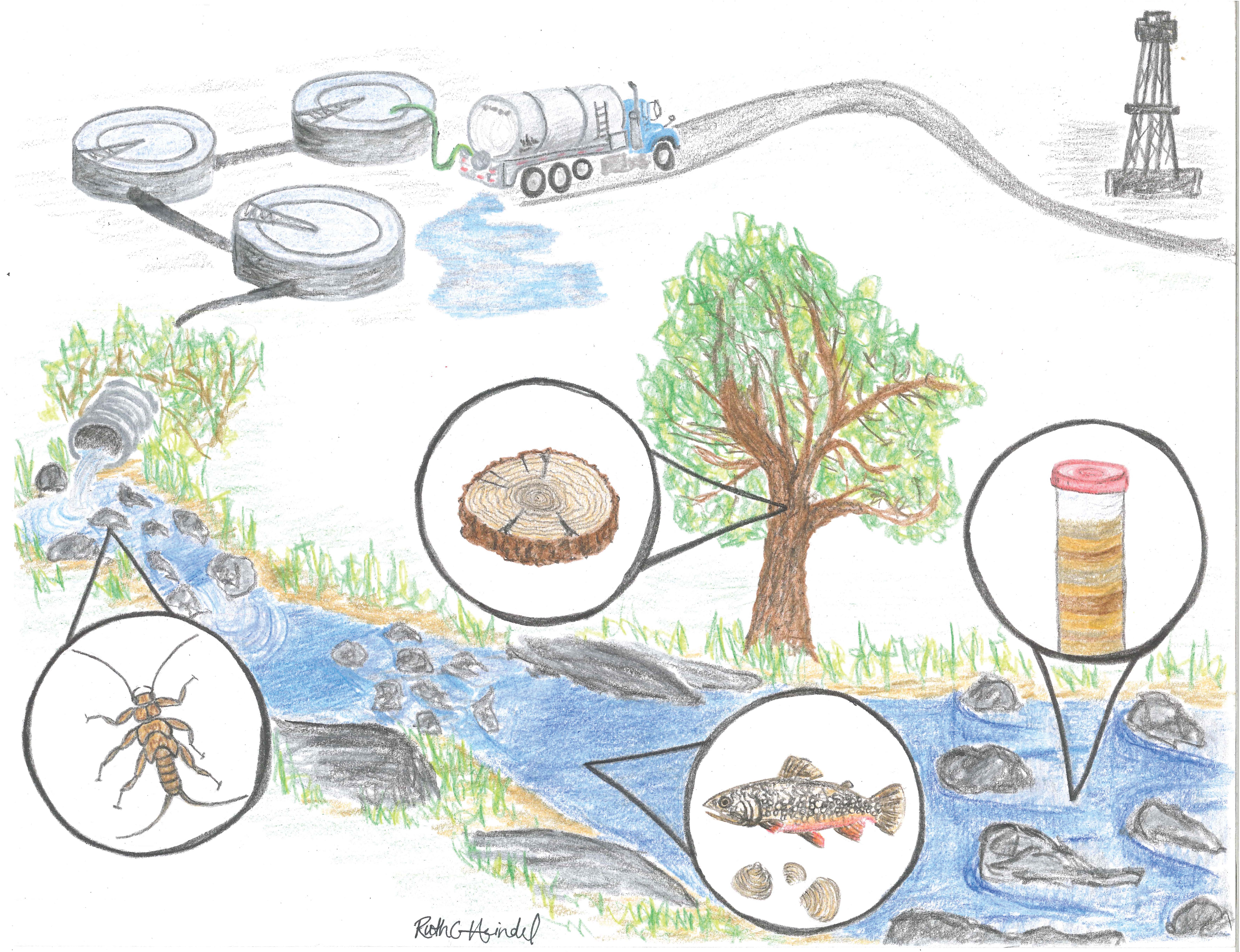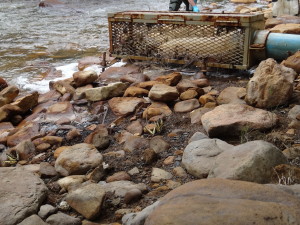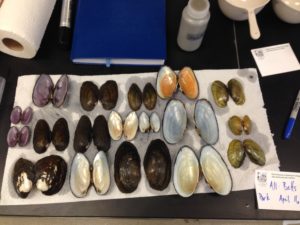 Tracing SALinity with IsoTopeS (SALTS) Lab
Tracing SALinity with IsoTopeS (SALTS) Lab
https://www.cee.psu.edu/academics/graduate/how-to-apply.aspx#Deadlines
Freshwater Bivalves as Biomonitors. This project includes a combination of field work and laboratory analysis. Bivalves are collected from multiple watersheds to track various pollution sources.
Once collected they are brought back to the lab to analyze both soft tissue and hard shell as indicators of water pollution. Pollution we monitor can include microplastics, PFAS, and oil and gas wastewater.
Beneficial Use of Oil and Gas Brine for Road Dust Suppression. This project includes a combination of field work and laboratory analysis. Samples of oil and gas produced water and road aggregate are collected from the field. Laboratory analysis of dust generation is then quantified and dust suppression efficacy of alternative products is evaluated.
Reservoir Lake Sediments Record Changes in Water Quality. This project will include a combination of field work and laboratory analysis. Sediment cores will be collected from reservoirs, frozen and brought back the lab for sectioning and analysis of porewater and sediment. Age models must be developed.
Today, not many topics in science invoke as much discussion among students or the general public as hydraulic fracturing. Unfortunately much of the current discussion revolves around hearsay and vague generalizations that are not guided by good research. This offers an important opportunity for future research that cannot only help produce clean energy, but also protect water resources and public health. This research also offers an opportunity to engage the general public and students to communicate the need for good science in order to solve these issues.
 Recently, we focused on assessing the impact on shallow groundwater and surface water from the rapidly expanding use of hydraulic fracturing and horizontal drilling technologies. These investigations have important implications for not only the energy future of the United States, but also the groundwater, surface water, and air quality of communities in areas of unconventional shale development. The far-reaching interest in research on hydraulic fracturing allows us to work collaboratively with researchers in various fields and from industry, other Colleges, Departments, and Universities.
Recently, we focused on assessing the impact on shallow groundwater and surface water from the rapidly expanding use of hydraulic fracturing and horizontal drilling technologies. These investigations have important implications for not only the energy future of the United States, but also the groundwater, surface water, and air quality of communities in areas of unconventional shale development. The far-reaching interest in research on hydraulic fracturing allows us to work collaboratively with researchers in various fields and from industry, other Colleges, Departments, and Universities.
The importance of sound science on issues of salinization, hydraulic fracturing, and unconventional oil and gas development is vital for the future direction of energy policy in the United States and internationally. Our current research will continue to expand in other shale formations and basins (e.g., Bakken, Utica) and help decrease the ambiguity surrounding the possible affect shale-gas drilling has on water resources. Each project outlined above has led to more research questions that we plan to (or are currently) address, incorporating additional student researchers in the process. Please contact me if you have interest in pursuing a graduate degree in Environmental Engineering at Penn State (nrw6 at psu.edu).
Previous funded research projects and pending proposals include:
Effects of Hydraulic Fracturing Wastewater Disposal on Stream Health –A biological assessment of macroinvertebrate communities in streams of western Pennsylvania that may be impacted by continued disposal of hydraulic fracturing wastewater and brines. Preliminary results, collected in summer 2014, indicate minimal impact to macroinvertebrate communities from wastewater disposal. However, the assessed streams display severe impairment relative to pristine streams. The impairment is likely the result of historical mining in the area that has led to acid mine drainage impacts and not oil and gas wastewater disposal.
Bioaccumulation of Radium in Western Pennsylvania Streams Associated with Oil and Gas Wastewater Disposal –Current oil and gas wastewater treatment at pollution control facilities in western Pennsylvania removes the vast majority (>90%) of the naturally occurring radioactive material (NORM) in hydraulic fracturing flowback fluids  and produced waters during treatment. However, large quantities of water with 226Ra and 228Ra activities between 20 and 60 pCi/L (activities above drinking water standard of 5 pCi/L) were/are currently released to surface water streams.
and produced waters during treatment. However, large quantities of water with 226Ra and 228Ra activities between 20 and 60 pCi/L (activities above drinking water standard of 5 pCi/L) were/are currently released to surface water streams.
At the point of discharge, radium accumulates in sediments at activities 200 times background levels. This study examines the possibility of radium bioaccumulation in freshwater mussels and mollusks in areas near the surface water discharge of oil and gas wastewater.
Beneficial Reuse of Hydraulic Fracturing Flowback and Produced Water: Reclaiming Clay and Sand from Hydrofracturing Fluids and Solids co-PI with Fred Cannon (PSU)
Funded: National Science Foundation Partnership for Innovation- Accelerating Innovation Research Technology Translation
This NSF PFI: AIR Technology Translation project will apply a novel sand-clay separation technology to processing hydrofracturing waste solid slurries, drilling muds, and fluids. This will allow the clays to be reused in drilling mud and other clay applications, and the sand to be reused as proppant, rather than being discarded as solid wastes. This project will help promote American energy independence, national security, and economic competitiveness, as it solves a huge issue in the natural gas industry—namely how to reclaim solids that are conventionally landfilled, and how to manage radium. More broadly, the solids reclamation and radium management strategies developed here could also be used at other natural gas and petroleum-extraction operations in PA, TX, WY, CO, WV, and LA. The reuse of the solids will  reduce traffic near hydrofracturing and decrease the volumes of waste hauled to landfills and the volumes of new material that is mined. The project will result in a pilot scale application of hydroacoustic cavitation –advanced oxidation (HAC-AO) for treatment of hydrofracturing waste solids. Importantly, HAC-AO offers the ability to treat solids in the presence of radium and hypersaline brines, when salt levels are 4-10 times higher than ocean water. This feature provides an advantage when compared to other technologies in this market space. When these solids can be reclaimed and reused, operations costs will be significantly diminished. For example, when HAC-AO was applied to a mixed hydrofracturing solid waste slurry, about 15-20% of the solids could be reclaimed as high-quality clay, and 35-45% reclaimed as good sand proppant. That left only 35-40% remaining to be wasted. When considering clay and sand purchasing costs, and solids landfilling fees, this reclamation represented several hundred dollars per ton for the reclaimed material that would conventionally be wasted.
reduce traffic near hydrofracturing and decrease the volumes of waste hauled to landfills and the volumes of new material that is mined. The project will result in a pilot scale application of hydroacoustic cavitation –advanced oxidation (HAC-AO) for treatment of hydrofracturing waste solids. Importantly, HAC-AO offers the ability to treat solids in the presence of radium and hypersaline brines, when salt levels are 4-10 times higher than ocean water. This feature provides an advantage when compared to other technologies in this market space. When these solids can be reclaimed and reused, operations costs will be significantly diminished. For example, when HAC-AO was applied to a mixed hydrofracturing solid waste slurry, about 15-20% of the solids could be reclaimed as high-quality clay, and 35-45% reclaimed as good sand proppant. That left only 35-40% remaining to be wasted. When considering clay and sand purchasing costs, and solids landfilling fees, this reclamation represented several hundred dollars per ton for the reclaimed material that would conventionally be wasted.
This project addresses the following technology gaps as it translates from research discovery toward commercial application. Specifically, clay-cation-radium interactions in the presence of hypersaline brines and cation-clay association kinetics, after the HAC-AO has exposed and activated fouled clay surfaces. Radium activities in hydrofracturing brines are often thousands of pCi/L range. Prior results show that the clays, when activated by HAC-AO, increase their capacity to capture radium. Importantly, this means that the other solids and liquids, when wasted, will conversely host less radium, making it unnecessary to truck them to radioactive waste sites; if more stringent regulations arise-as may happen. An HAC-AO system can reclaim both clay and silica sand proppant from hydrofracturing solid waste slurries and fluids. When the Penn State team processed hydrofracturing waste brines in these prior studies, nearly all of the otherwise wasted clay could be reclaimed.
During this project, graduate students will receive entrepreneurship experiences through interaction with the industrial partner.
Batch Method to Measure TDS Generation Potential from Coal Refuse co-PI with Bill Burgos (PSU) and Chuck Cravotta III (USGS)
Funded: Office of Surface Mines – Applied Science Program
High salinity releases to streams traced to coal mining and processing facilities have caused extensive fish kills and local extinction of sensitive aquatic organisms within the past decade (Associated Press and Steve Barrett, 2015; Cormier et al., 2013a, 2013b). At the same time, higher than normal concentrations of total dissolved solids (TDS), chloride, and bromide have been documented in the Allegheny and Monongahela Rivers in western Pennsylvania (Wang, 2014; Ziemkiewicz, 2015a), while a gradual increase in salinity attributed to chloride has been documented in major rivers in  the northeastern U.S.A. (Kaushal et al., 2005). Such observations in the northern Appalachian region may be explained by recent changes in resource extraction activities that can be influenced by residual brine in the rock, including the underground mining of coal to progressively deeper zones, the development of coal-bed methane, and the development of shale gas reserves in strata below the coal-bearing formations, notably the Marcellus Shale (Cravotta, 2015; Donovan and Leavitt, 2004; Donovan et al., 2015; Ziemkiewicz, 2015b). An understanding of the sources of salinity at local and watershed scales is necessary for the development of effective strategies to minimize and mitigate aquatic impacts from elevated TDS.
the northeastern U.S.A. (Kaushal et al., 2005). Such observations in the northern Appalachian region may be explained by recent changes in resource extraction activities that can be influenced by residual brine in the rock, including the underground mining of coal to progressively deeper zones, the development of coal-bed methane, and the development of shale gas reserves in strata below the coal-bearing formations, notably the Marcellus Shale (Cravotta, 2015; Donovan and Leavitt, 2004; Donovan et al., 2015; Ziemkiewicz, 2015b). An understanding of the sources of salinity at local and watershed scales is necessary for the development of effective strategies to minimize and mitigate aquatic impacts from elevated TDS.
 The purpose of this proposal is to develop and validate a simple, reliable, and rapid batch extraction method to measure the generation potential of total dissolved solids (TDS) from coal refuse and overburden materials. Previous OSMRE Applied Science Projects (Hornberger, 2005; Daniels, 2007; Daniels 2011) have developed flow-through column procedures to characterize the leaching potential of overburden materials and coal refuse. We plan to modify the approach of Hornberger et al. (2004, 2005), who used CO2-enriched fluids to drive carbonate mineral weathering, by adding H2O2 to drive sulfide oxidation, in an aggressive batch extraction mode to operationally define TDS generation potential. We plan to measure specific conductance, chloride, bromide, sulfate, sodium, calcium, magnesium, total inorganic carbon, and other ions in the standard paste (1 part pulverized rock + 2 parts deionized water) and the CO2-H2O2 extracts (1 part pulverized rock + 2 parts extractant). We also plan to measure standard paste pH and acid-base accounting (ABA) parameters for the rock samples. These water quality characteristics may differ depending on the mineral sources in the rock and the extractant. Most of these analytes have human health advisories, may be correlated to elevated TDS, and are included or likely to be added to state NPDES permits for coal mine outfalls in the near future. Technology transfer from this study to the coal industry, regulatory agencies, and engineering practitioners will occur at national and international mining conferences, at national scientific meetings, and through peer-reviewed publications.
The purpose of this proposal is to develop and validate a simple, reliable, and rapid batch extraction method to measure the generation potential of total dissolved solids (TDS) from coal refuse and overburden materials. Previous OSMRE Applied Science Projects (Hornberger, 2005; Daniels, 2007; Daniels 2011) have developed flow-through column procedures to characterize the leaching potential of overburden materials and coal refuse. We plan to modify the approach of Hornberger et al. (2004, 2005), who used CO2-enriched fluids to drive carbonate mineral weathering, by adding H2O2 to drive sulfide oxidation, in an aggressive batch extraction mode to operationally define TDS generation potential. We plan to measure specific conductance, chloride, bromide, sulfate, sodium, calcium, magnesium, total inorganic carbon, and other ions in the standard paste (1 part pulverized rock + 2 parts deionized water) and the CO2-H2O2 extracts (1 part pulverized rock + 2 parts extractant). We also plan to measure standard paste pH and acid-base accounting (ABA) parameters for the rock samples. These water quality characteristics may differ depending on the mineral sources in the rock and the extractant. Most of these analytes have human health advisories, may be correlated to elevated TDS, and are included or likely to be added to state NPDES permits for coal mine outfalls in the near future. Technology transfer from this study to the coal industry, regulatory agencies, and engineering practitioners will occur at national and international mining conferences, at national scientific meetings, and through peer-reviewed publications.
Monitoring Surface Water Quality and Bioaccumulation in Areas of Hydraulic Fracturing: Biogenic carbonates as indicators of changes in water chemistry of the Allegheny River through time
Biogenic carbonates have been used as proxies for pH, temperature, and salinity. Trace elements have also been studied in biogenic carbonates as indicators of metals concentrations in water. Much of the previous work utilizing mollusk shells as proxies is focused on reconstructing marine environments, paleo-climate, and temperature. This project aims to use mollusk shells collected in water impacted by oil and gas activity to reconstruct past water chemistry.
The latest paper on this project is featured in the NSF weekly brief (very brief) – “4 Awesome Discoveries You Probably Didn’t Hear About This Week.” Here are all the social media links for the video:
Facebook: https://www.facebook.com/US.NSF/videos/2284797098258748
Twitter: https://twitter.com/NSF/status/1056164004333318144
YouTube: https://youtu.be/8JOBaU4EtYQ
and a link to the story in the Penn State News:
GEO/ENG: Freshwater Mussels
Riparian bird feathers as indicators of shale gas development (co-PI with Margaret Brittingham (PSU) and Matthew Fantle (PSU)
Funded: the Institute for Energy and the Environment (IEE)
Feathers are commonly used for sampling exposure to environmental pollutants as many heavy metals and other pollutants become incorporated into the feather structure and are an indication of exposure during the time the feathers were growing. In particular, songbirds do not store calcium for egg shell production in their legs but instead need to obtain it in their diet by feeding on calcium rich items in the days preceding egg laying. Contaminants found in very high concentrations in oil and gas wastes such as barium, radium, and strontium could be important indicators of exposure because they follow and often replace calcium in biogeochemical cycles. The Louisiana waterthrush (Parkesia motacilla) is an obligate riparian songbird that feeds primarily on benthic macroinvertebrates and may bioaccumulate contaminants through their diet. Latta et al. (2015) observed higher concentrations of barium and strontium in Louisiana waterthrush feathers collected from active areas of shale gas development compared to areas with little or no gas development suggesting the possibility that bioaccumulation of barium and strontium had occurred in areas of shale gas development. While the higher strontium and barium concentrations may indicate potential impacts from oil and gas development (OGD), distinct isotopic signatures are necessary to distinguish OGD from other possible sources of contamination. Our goal is to establish methodology that links water quality within a watershed and subsequent bioaccumulation in a riparian bird species. We hypothesize that the element and isotopic ratios can be used to trace water contamination through the food chain. Through a collaboration with Dr. Latta, we propose to analyze the feathers collected during the Latta et al. (2015) study to determine whether the isotopic ratios (87Sr/86Sr) indicate a link between the observed bioaccumulation and OGD. Our results will show not only whether it is likely that the OGD is the source of contamination, but also demonstrate the use of 87Sr/86Sr as a new method to identify sources of contamination and track the movement of contaminants through the food chain.
Removing Radium from Hydrofracturing Fluids with Tailored Clays
co-PIs: Sridhar Komarneni Agricultural Sciences, Ecosystem Science and Management; Fred S. Cannon College of Engineering, Civil & Environmental Engineering; Marek Flaska College of Engineering, Mechanical and Nuclear Engineering; Amanda Johnsen College of Engineering, Radiation Science and Engineering Center
Funded: the Institute for Energy and the Environment (IEE)
Through this IEE seed grant, this interdisciplinary team aims to remove radium from hydrofracturing fluids by sorbing the radium onto tailored clays. Prior research has synthesized clays that host a tight inter-layer structure that captures radium, preferentially over other cations such as barium, sodium, etc. As a high-risk, high- gain application of this novel phenomenon, we aim to dose these tailored clays into hypersaline hydrofracturing fluids so as to sorb the fluids’ radioactivity. Hydrofracturing fluids often contain elevated radium radioactivity ~20,000 pCi/L, levels that may raise regulatory and health concerns. They also contain high levels of salts and barium, which confound removal technologies. Other possible contaminants of concern have not been well characterized because the saline matrices require a 1,000-10,000x dilution to run using conventional methods (e.g. ICP-MS).
Road Brines
Geochemical Modeling of Radium



















